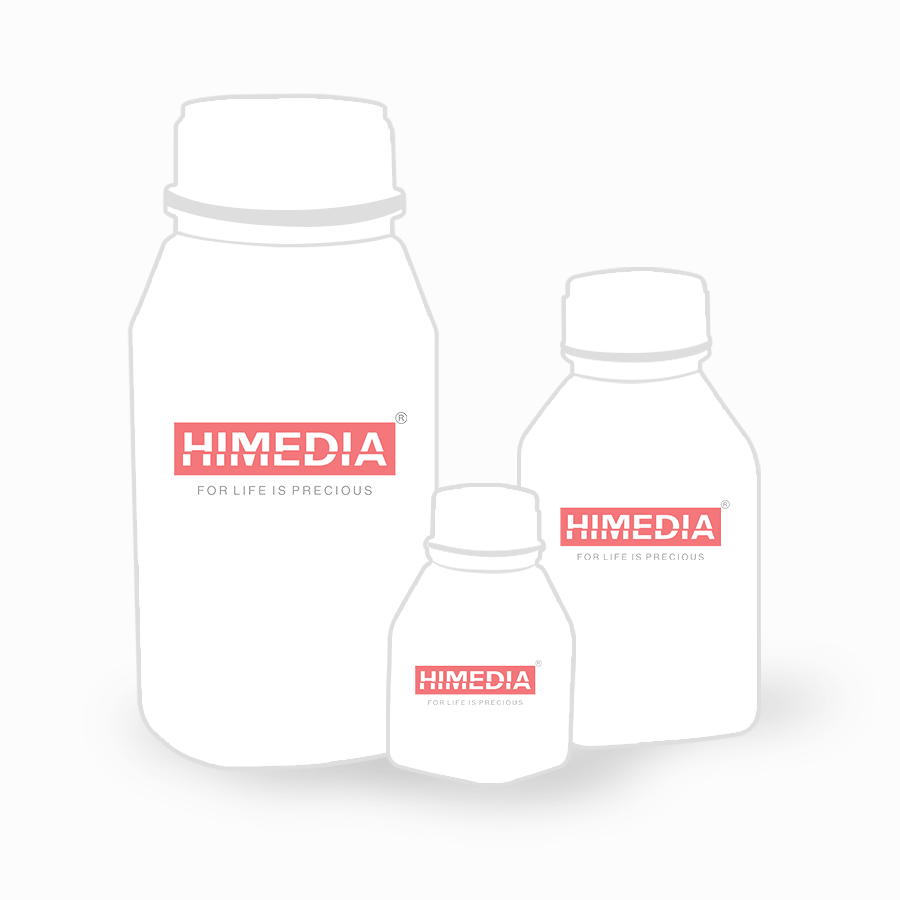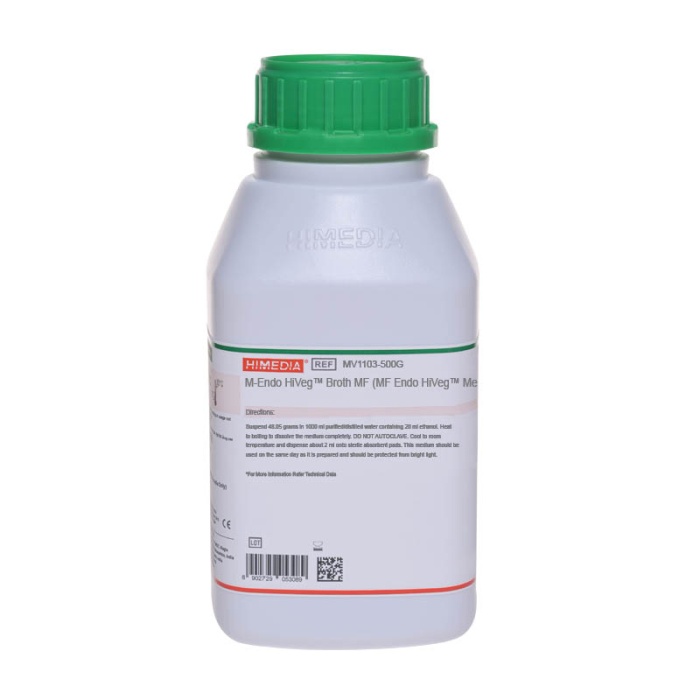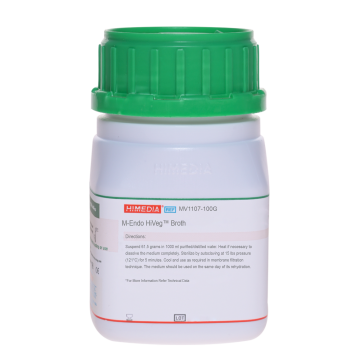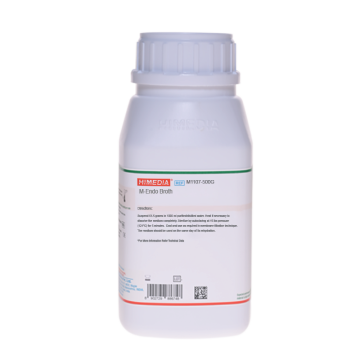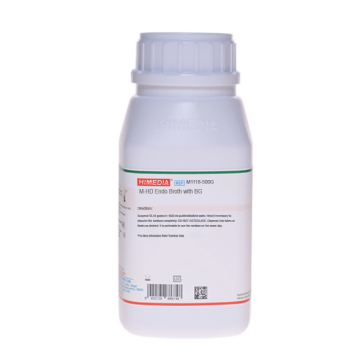 Your enquiry has been submitted
Your enquiry has been submitted
M-HD Endo Broth
Recommended for the detection of coliforms in water samples by membrane filter technique.
Composition**
| Ingredients | g/L |
|---|---|
| Tryptone | 10.000 |
| Peptone | 10.000 |
| Yeast extract | 3.000 |
| Lactose | 20.000 |
| Sodium deoxycholate | 0.200 |
| Sodium chloride | 5.000 |
| Dipotassium hydrogen phosphate | 6.000 |
| Sodium sulphite | 2.100 |
| Basic fuchsin | 0.840 |
Final pH (at 25°C): 7.5±0.2
**Formula adjusted, standardized to suit performance parameters
Directions
Suspend 57.14 grams in 1000 ml purified/distilled water. Heat if necessary to dissolve the medium completely. Dispense into sterile tubes or flasks as desired. DO NOT AUTOCLAVE. Use on the same day of preparation.
Principle And Interpretation
The coliform group consists of several genera of bacteria belonging to the family Enterobacteriaceae. Estimation or enumeration of these bacteria in water can be done by employing the membrane filter procedure. As related to the membrane filter technique, the coliform group is defined as those facultative anaerobic, gram-negative, non-spore forming rod shaped bacteria that develop red colonies with a metallic sheen at 35°C within 24 hours on an Endo- type medium containing lactose (1). M-HD Endo Broth is formulated as per Hajna and Damon (2) and is used for the estimation of coliforms in water samples by membrane filtration technique (3).
M-HD Endo Broth contains tryptone, peptone and yeast extract as source of essential nutrients including vitamins and B-complex nutrients. Lactose is the fermentable carbohydrate and energy source. Sodium deoxycholate is the selective agent, which helps to inhibit non-coliform bacteria. Sodium chloride maintains the osmotic equilibrium of the medium while dipotassium phosphate buffers the medium. Lactose-fermenting coliforms produce aldehyde and acid. The aldehyde in turn liberates fuchsin from the fuchsin-sulphite complex, giving rise to red coloured colonies. With Escherichia coli, this reaction is more pronounced as the fuchsin crystallizes, exhibiting a permanent greenish metallic luster (fuchsin luster) to the colonies.
Type of specimen
Water samples
Specimen Collection and Handling
Sterile cotton absorbent pads are saturated with around 2 ml of M-HD Endo Broth. Membrane filter through which the test water sample has been passed is aseptically placed on these saturated absorbent cotton pads containing the medium. Following an incubation at 35-37°C for 18-24 hours, lactose fermenting coliforms produce pink to rose red colonies with similar colouration to the medium. Non-lactose fermenting coliforms form colourless to faint colonies against the pink background. After use, contaminated materials must be sterilized by autoclaving before discarding.
Warning and Precautions :
Read the label before opening the container. Wear protective gloves/protective clothing/eye protection/face protection. Follow good microbiological lab practices while handling specimens and culture. Standard precautions as per established guidelines should be followed while handling specimens. Safety guidelines may be referred in individual safety data sheets
Limitations
- Further biochemical and serological tests must be carried out for further identification.
- Individual organisms differ in their growth requirement and may show variable growth patterns on the medium.
- Each lot of the medium has been tested for the organisms specified on the COA. It is recommended to users to validate the medium for any specific microorganism other than mentioned in the COA based on the user's unique requirement.
Performance and Evaluation
Performance of the medium is expected when used as per the direction on the label within the expiry period when stored at recommended temperature.
Quality Control
Appearance: Light pink to purple homogeneous free flowing powder
Colour and Clarity of prepared medium: Light pink coloured clear solution without any precipitate
Reaction: Reaction of 5.71% w/v aqueous solution at 25°C. pH: 7.5±0.2
pH: 7.30-7.70
Cultural Response
Cultural characteristics observed after an incubation at 35-37°C for 18-24 hours.
| Organism | Inoculum (CFU) | Growth | Colour of colony (on membrane filter) |
|---|---|---|---|
| Escherichia coli ATCC 25922 (00013*) | 50-100 | luxuriant | red to black with metallic sheen |
| # Klebsiella aerogenes ATCC 13048 (00175*) | 50-100 | luxuriant | red to black |
| Salmonella Typhi ATCC 6539 | 50-100 | luxuriant | colourless |
| Staphylococcus aureus subsp. aureus ATCC 25923 (00034*) | >=104 | inhibited |
Key: *Corresponding WDCM numbers. #- Formerly known as Enterobacter aerogenes
Storage and Shelf Life
Store between 10-30°C in a tightly closed container and use freshly prepared medium. Use before expiry date on the label. On opening, product should be properly stored dry, after tightly capping the bottle inorder to prevent lump formation due to the hygroscopic nature of the product. Improper storage of the product may lead to lump formation. Store in dry ventilated area protected from extremes of temperature and sources of ignition. Seal the container tightly after use. Product performance is best if used within stated expiry period.
Disposal
User must ensure safe disposal by autoclaving and/or incineration of used or unusable preparations of this product. Follow established laboratory procedures in disposing of infectious materials and material that comes into contact with sample must be decontaminated and disposed of in accordance with current laboratory techniques (4,5).
Reference
- Eaton A. D., Clesceri L. S. and Greenberg A. E., (Ed.), 1998, Standard Methods for the Examination of water and Wastewater, 20th Ed. American Public Health Association, Washington, D.C.
- Hajna A. A. and Damon S. R., 1954, Public Health Rep., 69, 58
- MacFaddin J. F., 1985, Media for Isolation-Cultivation-Identification-Maintenance of Medical Bacteria, Vol. 1, Williams and Wilkins, Baltimore.
- Isenberg, H.D. Clinical Microbiology Procedures Handbook 2nd Edition.
- Jorgensen, J.H., Pfaller, M.A., Carroll, K.C., Funke, G., Landry, M.L., Richter, S.S and Warnock., D.W. (2015) Manual of Clinical Microbiology, 11th Edition. Vol. 1.
| Product Name | M-HD Endo Broth |
|---|---|
| SKU | M1110 |
| Product Type | Regular |
| Physical Form | Powder |
| Origin | Animal |
| Packaging type | HDPE |
| References | 1. Eaton A. D., Clesceri L. S. and Greenberg A. E., (Ed.), 1998, Standard Methods for the Examination of water and Wastewater,20th Ed. American Public Health Association, Washington, D.C. |
| Customized Product Available | No |



